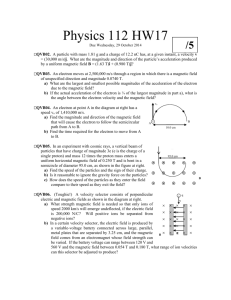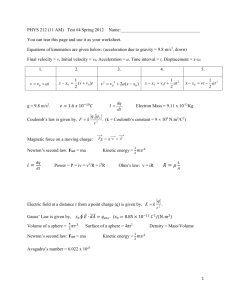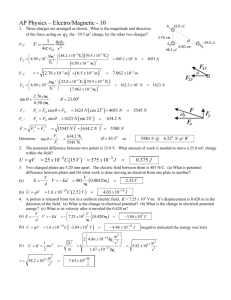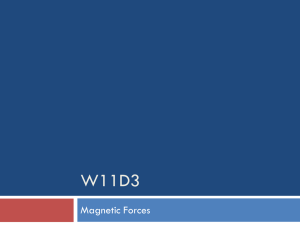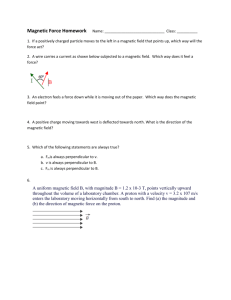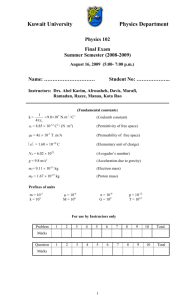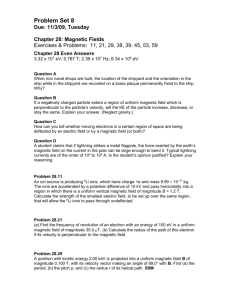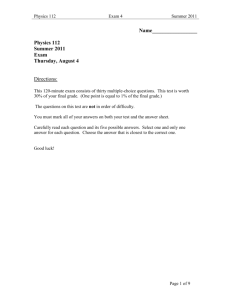Phys-202-Final
advertisement
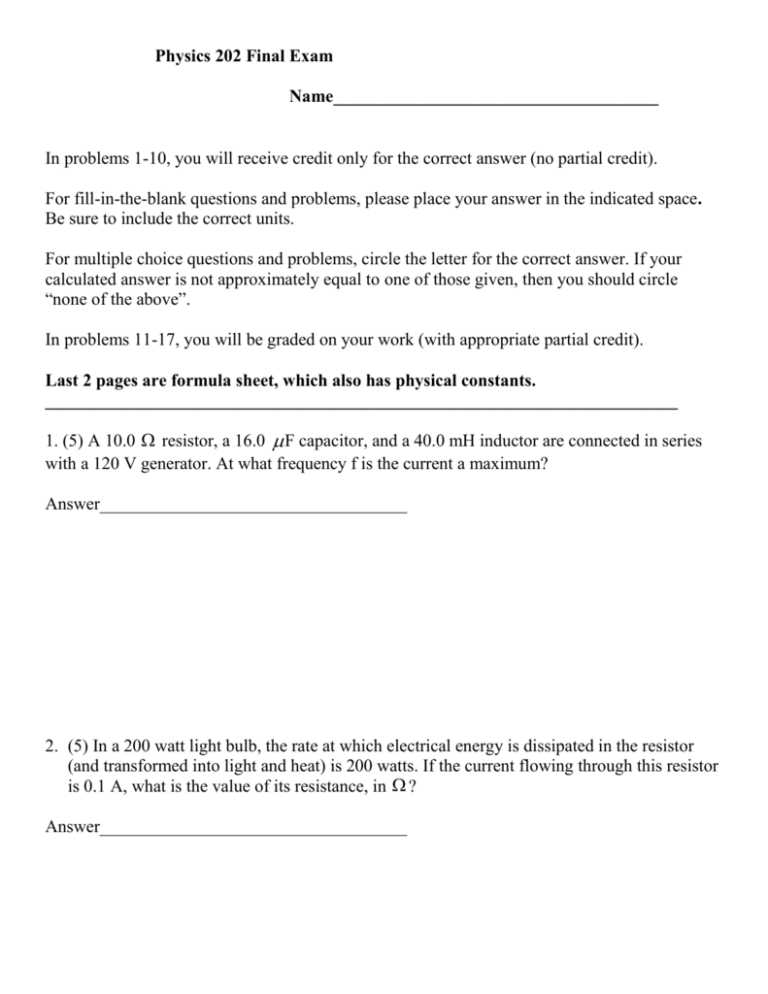
Physics 202 Final Exam Name_____________________________________ In problems 1-10, you will receive credit only for the correct answer (no partial credit). For fill-in-the-blank questions and problems, please place your answer in the indicated space. Be sure to include the correct units. For multiple choice questions and problems, circle the letter for the correct answer. If your calculated answer is not approximately equal to one of those given, then you should circle “none of the above”. In problems 11-17, you will be graded on your work (with appropriate partial credit). Last 2 pages are formula sheet, which also has physical constants. ________________________________________________________________________ 1. (5) A 10.0 resistor, a 16.0 F capacitor, and a 40.0 mH inductor are connected in series with a 120 V generator. At what frequency f is the current a maximum? Answer___________________________________ 2. (5) In a 200 watt light bulb, the rate at which electrical energy is dissipated in the resistor (and transformed into light and heat) is 200 watts. If the current flowing through this resistor is 0.1 A, what is the value of its resistance, in ? Answer___________________________________ 3. (5) The wingspan (tip-to-tip) of a particular jet airplane is 60 m. The plane is flying horizontally at a speed of 280 m/s. The vertical component of the earth's magnetic field is 5.0 10 6 T. Find the emf induced between the wing tips. Answer___________________________________ 4. (5) Circle the letters for all of the following statements that are true of electromagnetic waves. (a) The magnetic field is parallel to the direction of propagation. . (b) The magnetic field is perpendicular to the direction of propagation. (c) The electric field is parallel to the direction of propagation. (d) The electric field is perpendicular to the direction of propagation. (e) The electric field is parallel to the magnetic field. (f) The electric field is perpendicular to the magnetic field. (g) The electric field and magnetic field vary in phase with each other. (h) The electric field and magnetic field vary out of phase with each other by 90 . 5. (5) A cube is made of solid metal, and the length of each edge is 10.0 cm. A charge of 3.0 C is placed 5.0 cm directly above the center of one face. What is the value of the electric field at the center of the cube? Answer___________________________________ 6. (5) An electric force moves a charge of 2.0 10 4 C from point A to point B, and performs 12.0 102 J of work on the charge. What is the magnitude of the potential difference between these two points? Answer___________________________________ 7. (5) An electron moves vertically upward in a magnetic field that points vertically downward. The velocity of the electron is 20 000 m/s and the magnitude of the magnetic field is 4.5 T. What is the magnitude of the magnetic force on the electron? Answer___________________________________ 8. (5) The principal quantum number for an electron in an atom is 7, while the magnetic quantum number is 3. What possible values for the orbital (angular momentum) quantum number could this electron have? Answer___________________________________ 9. (5) In the reaction 238 234 4 92U 90Th2 He the nuclear masses are respectively 238.0508 u, 234.0436 u, and 4.0026 u. What is the energy released, in MeV? Answer___________________________________ 10. (5) The above reaction, in problem 9, is (a) a fusion reaction (b) a catalectic reaction (c) an arachniphobic reaction (d) an alpha decay (e) a beta decay (f) a gamma decay 11. Let us now return to a more detailed study of Problem 9. Recall that in the reaction 238 234 4 92U 90Th2 He the nuclear masses are respectively 238.0508 u, 234.0436 u, and 4.0026 u. Let mn,vn ,m ,v represent the mass and velocity of the thorium nucleus and the helium nucleus, respectively. (a) (3) Write down the equation for momentum conservation (The uranium nucleus is initially at rest.) (b) (3) Write down the equation for energy conservation, letting Problem 9. E represent your answer to (c) (8) Solve these equations for the kinetic energy of each product nucleus, and give your final answers below (Show all your work, of course.) kinetic energy of the 234 nucleus = ___________________________________ 90Th kinetic energy of the 24He nucleus = ___________________________________ 12. (14) A slit whose width is 6.0 105 m is located 4.0 m from a flat screen. Light shines through the slit and falls on the screen. Find the width of the central fringe of the diffraction pattern when the wavelength of the light is 550 nm. Answer___________________________________ 13. (14) We wish to measure the focal length of a converging lens. A bright lightbulb in a flashlight is held 0.6 m above the lens. The image of the filament in the bulb is brought to a sharp focus on a sheet of paper which is held 0.2 m below the lens. What is the focal length? Answer___________________________________ 14. (14) Bones of the wooly mammoth have been found in North America. The youngest of these bones has a 146 C activity per gram of carbon that is about 21% of what it was in the live animal. The half life for 146 C is 5730 years. How long ago (in years) did this animal disappear from North America? Answer___________________________________ 15. (14) A metal surface has a work function of 4.20 eV. Ultraviolet light with a wavelength of 200 nm shines on this surface, and photoelectrons are emitted. Find the maximum energy of these emitted electrons, in eV. Answer___________________________________ 16. (15) Two charges are placed on the x axis. One charge ( q1 4.0 C) is at x1 1.0 cm, and the other ( q2 2.0 C) is at x2 11.0 cm. Find the net electric field (magnitude and direction) at x 6.0 cm. Answers: magnitude __________________________________________ direction ___________________________________________ 17. In a series circuit, a generator (1600 Hz, 20 V) is connected to a 12 resistor, a 5.0 F capacitor, and a 7.0 mH inductor. (g) (9) Calculate the current through the circuit. Answer___________________________________ (b) (6) Calculate the voltage across each circuit element. Answers: resistor_____________ capacitor_____________ inductor_____________
